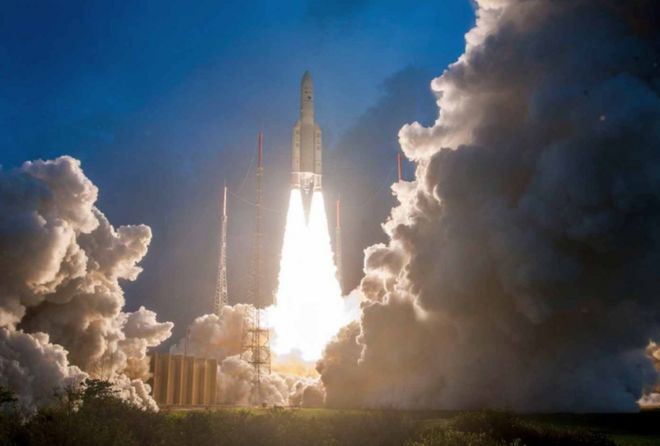 GSAT-11 is the next generation high throughput communication satellite that will play a vital role in providing broadband services across the country. It will also provide a platform to demonstrate new generation applications,
GSAT-11 is the next generation high throughput communication satellite that will play a vital role in providing broadband services across the country. It will also provide a platform to demonstrate new generation applications,
The "Big Bird" has cost about R
s.
600 crore. The ariane-5 heavyweight rocket was hired from Arianespace by ISRO. The satellite is expected to have a life span of 15 years
The satellite internet, which the GSAT-11 will help to provide, will aid in giving internet connectivity in flights in India.
The GSAT-11 is equivalent to the combined power of almost all communications satellites sent into orbit by India. A communications specialist told NDTV that the satellite is like a constellation of 30 classical orbiting satellites.
India has hired the French Ariane-5 rocket as it can heavy payload into orbit. India's own geosynchronous satellite launch vehicle MK iii or GSLV MK iii can haul satellites that weighs upto 4 tons.
Weighing about 5,854kg (12,906lb), the GSAT-11 is India's "most-advanced" multi-band communication satellite.
The Indian Space Research Organisation (Isro) launched the satellite from the Kourou spaceport in French Guiana early on Wednesday morning.
It will be placed in a geostationary orbit by the end of this month and its transponders will be switched on.
Isro chief K Sivan told reporters that the satellite will "play a vital role in providing broadband services across the country".
Scientists say it will provide internet access to "off-grid" remote areas in India - hills and islands, for example - where traditional fixed-line broadband services are not available and would be helpful during emergencies and disaster relief. And it will also help provide internet connectivity during air travel in India.
India hired a French rocket to carry the satellite, which is expected to have a life span of 15 years, because it does not have a rocket to carry such a heavy payload.
There are more than 440 million internet users in India, and the number is expected to double by 2022.
However, slow speeds or lack of services still affect access in the remotest areas where is there is no cable connectivity.
India has emerged as a major player in the multi-billion dollar space market with dozens of communication and weather satellites in orbit.
In 2014, it successfully placed a space vessel in orbit around Mars, making it the first nation in the world to do so in its first attempt.
It also launched 104 satellites of varying sizes in one go in 2017, overtaking the previous record of 37 satellites launched by Russia in 2014.

No comments:
Post a Comment